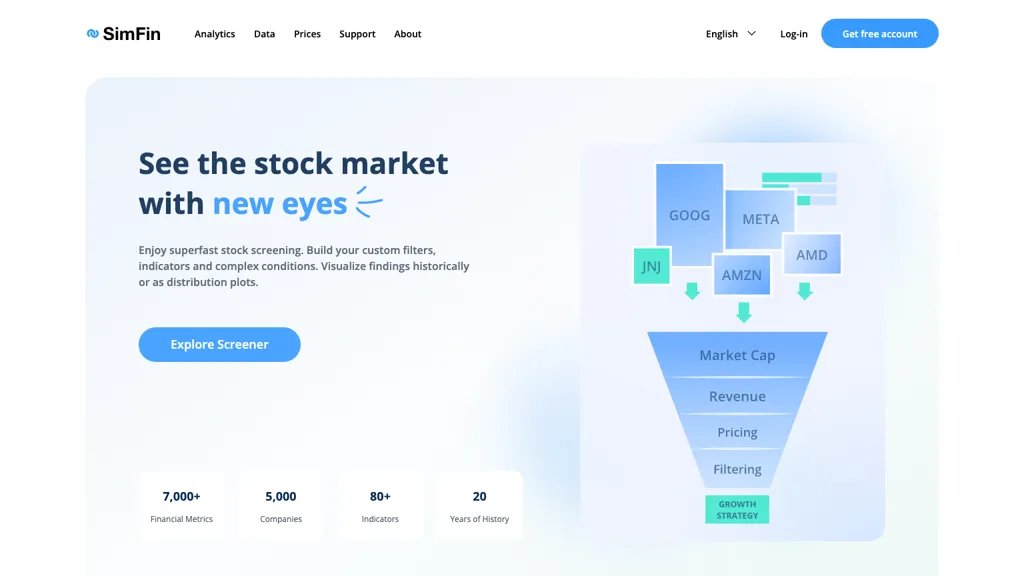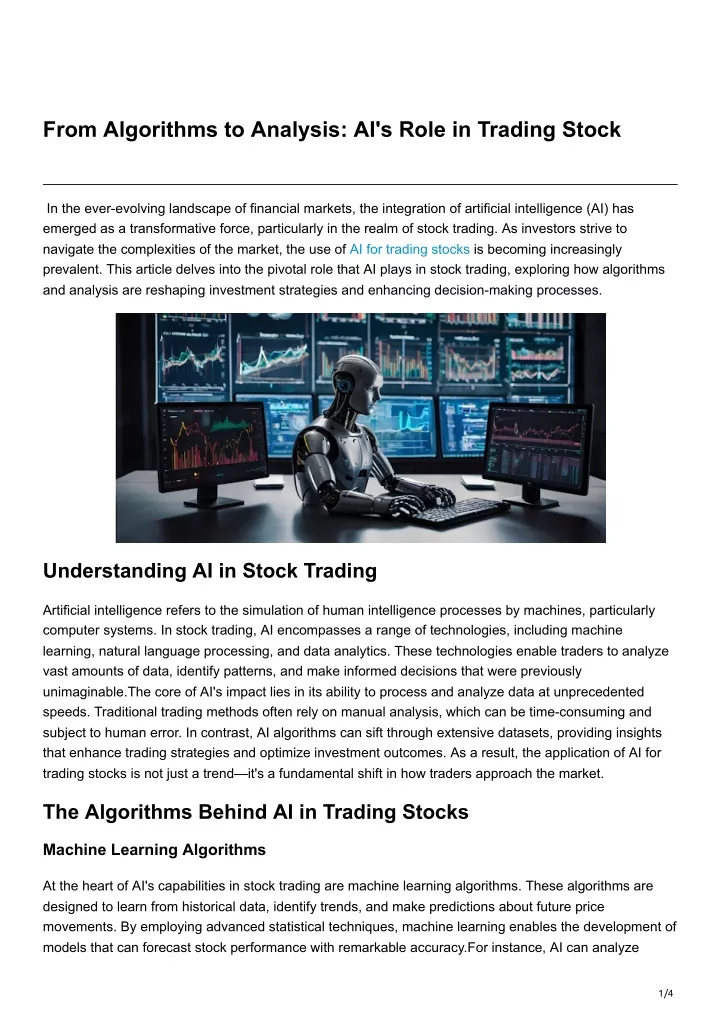20 Excellent Suggestions On Deciding On AI Stock Trading Platform Websites
20 Excellent Suggestions On Deciding On AI Stock Trading Platform Websites
Blog Article
Top 10 Tips To Customize Ai Trading Platforms For Your Strategy
AI trading platforms that forecast or analyze stocks are renowned for their capacity to modify strategies that meet the needs of their users. This enables them to adjust to specific goals and conditions, such as risk tolerance. Platforms that offer powerful customization options will increase the efficiency of your trading. Here are the top 10 suggestions to evaluate the capabilities to customize strategies on these platforms:
1. Evaluate Pre-Built Strategy Templates
Variety of Templates: Verify if the trading platform provides templates that are pre-built for various trading styles (e.g. Day Trading or Swing Trading, Long-Term Investing).
You can easily modify the templates and tailor them to meet your needs.
Performance history: Verify that the platform has historical data about performance for the strategic plans that have been pre-built.
2. Assessment Custom Strategy
Drag-and-drop applications: Search for platforms that provide intuitive drag and drop interfaces for customizing strategies.
Coding options: Determine whether the platform allows custom coding (e.g., Python, R or other proprietary scripting languages) for advanced users.
Flexibility - Make sure that the platform you choose allows you to set rules for the entry and exit of your business, as well as parameters for risk management, as well as other essential components of your strategic plan.
3. Check for Backtesting Capabilities
Historical data: Determine if there are enough data to backtest your strategies.
Modifiable parameters: Make sure you have the ability to alter parameters (e.g. timespans, timeframes or indicators) during backtesting.
Performance metrics - Check to see if your software provides detailed performance indicators (e.g. the winning rate, Sharpe coefficient, or drawdown) for all strategies tested back.
4. Evaluate Real-Time Strategy Testing
Paper trading Try out strategies in real-time using simulation or paper trading.
Live testing: Determine if you are able to test your strategies on real market conditions with small amounts of capital.
Real-time adjustments - Check if you are able to adjust your strategies in real time based on the market conditions.
5. Assess Integration with Technological Indicators
Indicator library - See whether the platform has a comprehensive collection of technical indicators, such as moving averages (e.g. RSI), MACD or RSI.
Custom indicators you should be able to develop or import your own indicators which you can utilize in your strategy.
Verify the indicators' combination.
6. Check for Risk Management Tools
Stop-loss/take-profit: Ensure the platform allows you to set stop-loss and take-profit levels within your strategies.
Position sizing: Check whether you are able to define position sizing rules (e.g. fixed amount percent of portfolio) to reduce the risk.
Risk-reward ratio: Examine the support of the platform to set risk/reward ratios on specific trades or trading strategies.
7. Evaluate Multi-Asset Strategy Support
Asset classes: Make sure that the platform supports strategies across multiple asset classes (e.g. ETFs, stocks Forex, ETFs).
Cross-asset strategies: Determine whether you can develop strategies that use multiple asset classes (e.g., pairs trading, hedging).
Market coverage: Make sure the platform you are interested in covers the markets that are of interest to you (e.g. US or international copyright, for instance).
8. Review Automation & Execution
Automated Trading: Verify whether the platform is able to execute strategies automatically that are based on predefined rules.
Types of orders: Determine if the platform supports various kinds of orders (e.g. market, limit, stop) for strategy execution.
Latency: Ensure that the platform you are using has a low latency when trading, particularly if you use high-frequency strategies.
9. Check for strategy optimization tools
Parameter optimization: Ensure the platform has tools for optimizing strategy parameters (e.g., grid search, genetic algorithms).
Machine learning integration: Check that the platform utilizes machine learning to refine and optimization of strategies.
Scenario Analysis: Check if the platform supports testing strategies in various market scenarios (e.g. bull or bear, volatile).
Check out the User Feedback and Community Feedback
User reviews: Review user feedback in order to determine the platform's capacity to customize strategies.
Community forums: Check whether you can find a forum where users discuss and share their custom strategies.
Support resources - Make sure that the platform provides guides and instructions for users to develop and enhance strategies.
Bonus Tips:
Trial period: Use the trial period for free to test strategy customization capabilities.
Scalability: Ensure the platform is able to handle more complicated strategies as your trading expands.
Support for customers: See whether you can seek assistance with strategy-related questions or issues.
Follow these tips to assess the AI platform's stock prediction/analyzing capabilities and capability to modify strategies. By doing so you can ensure you select a platform which matches your needs in trading and lets you create and improve your individual strategies. A platform with flexible options for customization can allow you to adjust to changing market conditions and improve your trading performance. Check out the most popular ai investing hints for more advice including ai trade, trading with ai, ai for stock trading, best ai for trading, incite, ai for stock predictions, ai investment app, ai investment platform, trading with ai, ai for stock trading and more.
Top 10 Tips To Evaluate The Effectiveness Of Ai Stock Predicting/Analyzing Trading Platforms
To ensure that AI-driven stock trading and prediction platforms can be scaled as well, they should be able to deal with the ever-growing volume of data and complexity in markets, and also customer demands. Here are 10 tips for evaluating scalability.
1. Evaluate Data Handling Capacity
Tips: Make sure the platform is able to process and analyze large datasets (e.g., historic stock data, real-time market feeds, as well as alternative data such as news and social media).
Why: Scalable platforms must handle increasing data volumes without compromising performance.
2. Test the Real-Time Processing Capabilities
Tips: Make sure you check the platform's ability to handle real-time information streams, such live stock prices or breaking news.
The reason: Real-time analysis is critical to make trading decisions. delays could result in missing opportunities.
3. Examine the Cloud Infrastructure for Elasticity
Tips: Determine whether the platform has the ability to dynamically scale resources and utilizes cloud infrastructure (e.g. AWS Cloud, Google Cloud, Azure).
Why: Cloud-based platforms provide elasticity. They allow the system to scale down based on the need.
4. Algorithm Efficiency
Tips: Examine the computational efficacy of AI models (e.g. deep learning or reinforcement learning, etc.)) employed to predict.
Why: Complex algoriths are resource-intensive, so the ability to optimize these algorithms is vital to scalability.
5. Investigate Parallel Processing and Distributed Computing
Tips: Check that the platform supports parallel processing frameworks or distributed computing frameworks.
The reason: These technologies speed up data processing and analysis on multiple nodes.
Examine API Integration. API Integration.
TIP Try to test the platform's capacity to connect with APIs from outside (e.g., brokerage APIs, market data providers APIs).
Why? Seamless integration allows the platform to be adapted to new trading environments as well as data sources.
7. Analyze User Load Handling
Try simulating high traffic levels to test how your platform performs.
Why: A platform that can scale should be able to sustain performance even as the number of users increases.
8. Evaluation of Model Retraining and adaptability
TIP: Assess how frequently and efficiently AI models are trained by new data.
Why? Models have to constantly adjust to changing markets in order to remain accurate.
9. Check Fault Tolerance (Fault Tolerance) and Redundancy
Tip: Make sure the platform is equipped with failover mechanisms to handle software or hardware failures.
Reason Trading is expensive So the ability to handle faults and scale are crucial.
10. Monitor Cost Efficiency
Analyze costs associated with scaling up the platform. This includes cloud resources, data storage, as and computational power.
Reason: Scalability should not come at an unsustainable cost So balancing performance and cost is crucial.
Bonus Tip Future-Proofing
Platforms should be designed to integrate emerging technologies like quantum computing as well as advanced NLP. They should also adjust to regulatory changes.
By focusing your focus on these elements, you can accurately assess the capacity of AI prediction as well as trading platforms. This ensures that they are durable, efficient, and also ready for further growth. See the recommended ai stock trader for more recommendations including invest ai, ai copyright signals, stock trading ai, ai for trading stocks, investing with ai, chart ai trading, ai stock investing, best ai stocks, best ai trading platform, ai options and more.